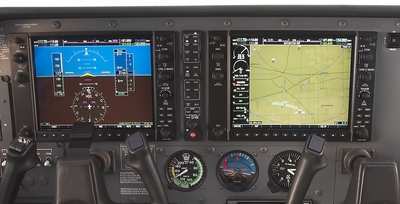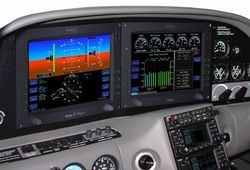Aims To Show Benefits, Challenges Of Technologically Advanced
Aircraft
 So-called "glass cockpit" aircraft
deliver multiple safety benefits to general aviation (GA) pilots
and have fueled industry growth, but pilot training must still
evolve to address the safety challenges posed by Technologically
Advanced Aircraft (TAA), according to a soon-to-be-released study
of accident data by the AOPA Air Safety Foundation.
So-called "glass cockpit" aircraft
deliver multiple safety benefits to general aviation (GA) pilots
and have fueled industry growth, but pilot training must still
evolve to address the safety challenges posed by Technologically
Advanced Aircraft (TAA), according to a soon-to-be-released study
of accident data by the AOPA Air Safety Foundation.
"TAA are neither as good as proponents say nor as bad as
detractors contend," said AOPA Air Safety Foundation Executive
Director Bruce Landsberg at M5, the fifth annual fly-in of the
Cirrus Owners and Pilots Association (COPA). "These aircraft
provide situational awareness tools that have dramatically improved
aspects of GA safety. But those tools are not enough to overcome a
pilot's faulty decision-making or a lack of experience in how those
aircraft are operated."
Set to be released in July, the study analyzed accidents that
occurred between 2003 and 2006 of new and existing aircraft designs
that were outfitted with a glass cockpit. Manufacturers included
Beech, Cessna, Cirrus, Columbia, Diamond, Mooney and New Piper. The
study updates an earlier report published in 2004.
Landsberg said that industry excitement over TAA has
reinvigorated GA aircraft sales and attracted more people to learn
to fly. The new study finds that some TAA capabilities such as a
moving map, fuel management systems and widescreen attitude
indicator displays have helped to substantially reduce fuel
management and maneuvering flight accidents as compared to aircraft
equipped with traditional “steam gauge”
instrumentation.

However, the report shows that TAA fare worse than the non-TAA
fleet in areas including landing and go-around accidents related to
the high-performance aerodynamic design of many new aircraft. TAA
accident data also were up to three times worse than the non-TAA
fleet in weather-related accidents due in part to how many
relatively new pilots use TAA in a wider range of conditions. The
study found that weather-related accidents accounted for nearly 45
percent of all glass cockpit fatal accidents compared to 16 percent
for the GA fleet.
"These accidents are not the fault of the airplane," said
Landsberg. "As the famed aviator Antoine de Saint Exupery said,
'The machine does not isolate us from the great problems of nature
but plunges us more deeply into them.' Instead, we as an industry
are still playing catch-up on the training aspects of TAA. We are
making progress but we don't yet have all of the tools."
 Among the training
challenges are teaching new pilots to be informed and efficient
"systems managers" in addition to having sound "stick-and-rudder"
skills and in using capabilities such as terrain proximity and
datalink weather displays without becoming overly reliant on the
technology.
Among the training
challenges are teaching new pilots to be informed and efficient
"systems managers" in addition to having sound "stick-and-rudder"
skills and in using capabilities such as terrain proximity and
datalink weather displays without becoming overly reliant on the
technology.
"TAA are a continuing positive evolution, but not a revolution,
in GA," said Landsberg. "TAA can give us better knowledge of the
nature of flying. But the technology is not a panacea because human
nature is still alive and well. We are addressing some fundamental
issues in GA training but there is a lot more to be done."
The AOPA Air Safety Foundation is the world's largest non-profit
GA safety organization. It was founded in 1950 solely to help
general aviation pilots improve flight safety. ASF produces live
seminars, online interactive courses, training DVDs, written Safety
Advisors and other aviation safety materials for free distribution
to all GA pilots.
 ANN's Daily Aero-Term (04.24.24): Runway Lead-in Light System
ANN's Daily Aero-Term (04.24.24): Runway Lead-in Light System ANN's Daily Aero-Linx (04.24.24)
ANN's Daily Aero-Linx (04.24.24) Aero-FAQ: Dave Juwel's Aviation Marketing Stories -- ITBOA BNITBOB
Aero-FAQ: Dave Juwel's Aviation Marketing Stories -- ITBOA BNITBOB Classic Aero-TV: Best Seat in The House -- 'Inside' The AeroShell Aerobatic Team
Classic Aero-TV: Best Seat in The House -- 'Inside' The AeroShell Aerobatic Team Airborne Affordable Flyers 04.18.24: CarbonCub UL, Fisher, Affordable Flyer Expo
Airborne Affordable Flyers 04.18.24: CarbonCub UL, Fisher, Affordable Flyer Expo





